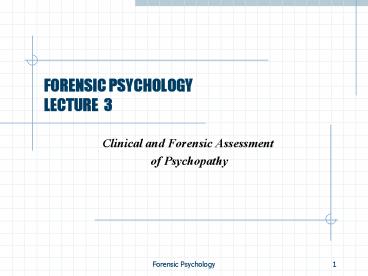FORENSIC PSYCHOLOGY LECTURE 3 - PowerPoint PPT Presentation
1 / 18
Title:
FORENSIC PSYCHOLOGY LECTURE 3
Description:
FORENSIC PSYCHOLOGY LECTURE 3 Clinical and Forensic Assessment of Psychopathy Recommended Reading Gacono, Carl B. (2000), The Clinical and Forensic Assessment of ... – PowerPoint PPT presentation
Number of Views:233
Avg rating:3.0/5.0
Title: FORENSIC PSYCHOLOGY LECTURE 3
1
FORENSIC PSYCHOLOGYLECTURE 3
- Clinical and Forensic Assessment
- of Psychopathy
2
Recommended Reading
- Gacono, Carl B. (2000), The Clinical and Forensic
Assessment of Psychopathy Practitioners Guide.
London Lawrence Erlbaum Associates. (Chapters 3,
4, 6, 7, 8, 10, 13). - Howitt, Dennis), (2009) , Introduction to
Forensic and Criminal Psychology 3rd Edition.
London Pearson Prentice Hall Chapter 20. - Millon, Theodore Simonsen, Erik Birket-Smith,
Morten and Davis, Roger D. (1998), Psychopathy
antisocial, criminal and violent behaviour. New
York Guilford. (Reading Chapters 1, 2, 4, 6, 9,
12, 10, 12, 27). - Articles
- Hare, Robert D. (1998). The Hare PCL-R Some
issues concerning it's use and misuse. Legal and
Criminal Psychology. 3, 99-119. - Herpertz, Sabine and Sass, Henning (1997).
Psychopathy and antisocial syndromes. Current
Opinion in Psychiatry. 10, 436-440.
3
Aims of Lecture
- Examine the link between mental illness and crime
- Describe what is meant by the term psychopathy
and understand the difficulties associated with
defining psychopathy - Describe the usefulness of the Hare Psychopathy
Checklist Revised (PCL-R). - Examine the concept of assessing risk and
recidivism in forensic populations.
4
Mental Illness and Crime
- Concept of Mental Illness is perceived in
different ways between the professions of
psychology and law. The media have an effect on
the public perception of mental illness and
crime. - Link et al (1992) Sample of 500 never treated
residents/mental patients in NYC. Psychiatric
Epidemiology Research Interview assessing
mental illness symptoms. Although patients
reported higher levels of violence, age, gender
and education level were a higher predictor of
violent behaviour than psychotic symptoms.
5
Mental Illness and Crime
- Swanson (1990) US study using the Diagnostic
Interview Schedule. While schizophrenia was
associated with violence, substance abuse was a
greater predictor in the likelihood of violent
behaviour. - Hodgins (1997) Stockholm 15,000 born in 1953
- MEN - 32 with no mental illness criminals/ 50
of mentally ill criminal - WOMEN - 6 with no mental illness criminals/
19 of mentally ill criminal - Why?
6
History of Psychopathy
- We cannot treat, except empirically, what we do
not understand and we cannot prevent what we do
not comprehend - Brittain (1970)
- Pinel (1800s)
- Manie Sans Delire insanity without a
confusion of mind. - Patients engaged in impulsive and self damaging
acts, despite the fact that their reasoning was
intact and that they knew what they were doing
was irrational.
7
History of Psychopathy
- Cleckley (1976) The Mask of Sanity Proposed
that psychopaths present a convincing mask with
superficial charm, good intelligence, etc, yet
are impulsive, have poor judgment and lack
remorse. - 16 characteristics including interpersonal,
affective, cognitive and behavioural
characteristics associated with an impulsive,
irresponsible lifestyle.
8
Cleckleys Characteristics
- Superficial Charm
- Absence of Delusions
- Absence of Nervousness
- Unreliability
- Lying
- Lack of Remorse
- Anti-social Behaviour
- Poor Judgment
- Egocentric
- Poor Reactions
- Lack of insight
- Unresponsiveness in interpersonal relations
- Alternative behaviour
- Threat of Suicide
- Promiscuous
- Lack of Life Plan
9
Terms
- Antisocial Personality Disorder(ASPD)
- Sociopathy
- Psychopathy
- (Terms used interchangeably in the literature)
- Sociopathy diagnosis in DSM I sexual deviation,
alcoholism and anti-social behaviour were
features.
10
Anti Social Personality Disorder
- 18 years
- Conduct Disorder before age 15
- Violations of law
- Disregard for others/self
- Deceitfulness
- Impulsivity
- Irritable/aggressive
- Lack of Remorse
11
Hare Psychopathy Checklist
- PCL-R 20 item 40 point scale completed with a
semi-structured interview, and a review of
independent and historical and contemporaneous
data - PCL-SV 12 item scale
- Factor 1 Interpersonal/affective features
callousness, lack of remorse. - Factor 2 behavioural/affective features
socially deviant lifestyle.
12
Hare Psychopathy Checklist
- Glibness/Superficial Charm
- Grandiose sense of self-worth
- Need for stimulation/proneness to boredom
- Pathological Lying
- Conning/Manipulative
13
Hare Psychopathy Checklist
- Lack of remorse or Guilt
- Shallow Affect
- Callous/Lack of Empathy
- Parasitic Lifestyle
- Poor Behavioural Controls
14
Hare Psychopathy Checklist
- Promiscuous Sexual Behaviour
- Early Behavioural Problems
- Lack of Realistic Long Term Goals
- Impulsivity
- Irresponsibility
15
Hare Psychopathy Checklist
- Failure to accept Responsibility for Own Actions
- Many Short Term Marital Relationships
- Juvenile Delinquency
- Revocation of Conditional Release
- Criminal Versatility
16
Anti Social Personality Disorder/Psychopathy
- Behavioural Criteria in ASPD behaviour that is
observable and can be agreed on by clinicians,
but - Does not inform us about character
- Does not predict behaviour
- Does not suggest any specific type of treatment
- Most psychopaths will meet criteria for DSM ASPD
but ASPD will not meet criteria for
psychopathy
17
Anti Social Personality Disorder/Psychopathy
- Psychopathy behavioural criteria and
personality traits - APA (1994) forensic population study
- 80 met criteria for ASPD
- 15-25 met criteria for psychopath.
- Quinsey, Rice Harris follow-up study of
offenders(1995) - Psychopath 80 committed offences
- Non-psychopath 20 committed violent offences
18
Administration of PCL-R
- Historical information
- Record review
- Clinical Interview
- Greater than or equal to 30 psychopath
- Over 32.5 likely to be violent .































